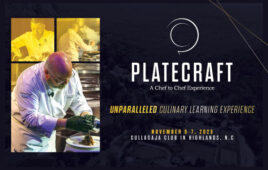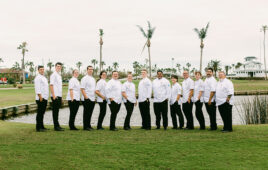By Jerry Schreck, Executive Chef, Merion Golf Club, Ardmore, Pa.
Concern for the fragile Martha’s Vineyard ecosystem was high in the late ‘90s, when a group of developers proposed construction of the first new golf course on the island in over 30 years. First, they had to commit to reduce the overall area of managed turf, be pesticide-free and use only organic fertilizer. Secondly, there was no model to follow, since this had never been done before.
CHEF PROFILE
Current Position: Executive Chef, The Vineyard Golf Club, Edgartown, Martha’s Vineyard, Mass. (2002-present)
 Previous Experience:
Previous Experience:
- Executive Chef, Eastward Ho! Country Club, Chatham, Mass. (1988-2002)
- Executive Chef, Oxford Golf and Racquet Club, Oxford, Mass. (1986-1988)
- Chef/Owner, Café Elizabeth, Harwich Port, Mass. (1982-1986)
Education:
- Ecole Ritz Escoffier, Paris
- Continuing Education, Culinary Institute of America, Hyde Park, N.Y.
- La Varenne, The Greenbrier
- Club & Resort Business Chef to Chef Conference (2012, New Orleans and 2011, San Francisco)
Looking back, proprietary members of The Vineyard Golf Club can now say they have a piece of one of the most environmentally sensitive golf courses in the world. What was a 235-acre failed housing development is now a relaxing world-class golf venue in one of the most beautiful places on earth.
The food at The Vineyard Golf Club is exceptional as well. Executive Chef Mark Chaput has been given free reign since the club opened in 2002 to create a world-class dining room. He has done just that, despite the challenges of running a seasonal operation in an out-of-the-way location. We thank him for taking time during his busiest month of the year to share insights into his success.
 The Vineyard Golf Club was the first new course to be built on Martha’s Vineyard in
The Vineyard Golf Club was the first new course to be built on Martha’s Vineyard in
30 years when it opened in 2002.
Q. Chef, you are on an island with a short season, so your major challenge is obvious. How have you been able to staff your kitchen and the rest of the club?
A. Living on an island is challenging all by itself, and running a seasonal business is quite difficult. Staffing is undeniably our biggest obstacle. We spend a large portion of our winter months recruiting our employees for a five-month season. In the past, we’ve traveled to Florida and hired staff at golf clubs where the seasons run opposite to ours. We also attend career fairs at C.I.A., Johnson & Wales and Cordon Bleu, which has worked quite well for us. We’ve managed to retain some of our best help through the years; my Chef de Cuisine is on his eleventh year and our two Sous Chefs have been here for several years. We also have many students from Eastern Europe who spend summers on the Island and work as line cooks, servers, busers and dishwashers.
Q. Is procuring everything you need to operate a fine-dining restaurant equally challenging?
A. Before moving to the Island, I assumed getting quality product was going to be difficult. It turns out it’s just the opposite. Because there are so many excellent restaurants here that are packed every night, every major purveyor delivers on a regular basis. Sysco, for example, delivers six days a week. And I have access to the freshest local seafood and produce every day we’re open. However, we do pay a little more, since traveling to the Island is expensive.
 Executive Chef Mark Chaput (far right) has the support of a well-tenured culinary
Executive Chef Mark Chaput (far right) has the support of a well-tenured culinary
staff at The Vineyard GC, including (from left) Sous Chef Brian Murray, Sous
Chef Marnely Rodriguez-Murray and Chef de Cuisine Anthony Rabeni.
Q. Chef, we are all running our club kitchens more and more like upscale public restaurants. This goal was communicated to you ten years ago when the club was built. You have worked at other clubs, so you know what we do on a daily basis. What is it like having just an a la carte focus without outside parties, swim meets, weddings, etc.? Does it even feel like a club kitchen?
Fillet of Local Yellowtail Veronique
Serves four
| Amt | Ingredient |
| 1 lb. | yellowtail flounder [8 small fillets] |
| 10 ea. | red seedless grapes, cut in half |
| 10 ea. | green seedless grapes, cut in half |
| 16 ea. | blanched asparagus spears |
| 1 cup | seasoned flour |
| 4 | large eggs, seasoned and whipped |
| 2 ea. | blanched and shelled 1-¼ lb. lobsters prepared citrus beurre blanc |
- Warm four half-lobster tails and four lobster claws in beurre blanc.
- Dredge yellowtail fillets in flour, then in egg batter, and pan sauté approximately 30 seconds on each side till golden.
- Grill seasoned and buttered asparagus spears and place four on each plate.
- Top with two each yellowtail and one half-lobster tail and one lobster claw.
- Surround with both grapes and top with warm lobster butter sauce.
A. When I was hired, the three original developers expressed their vision for a high-end upscale restaurant without the typical buffets, weddings etc.—and I feel we achieved that. In recent years, however, we’ve added a bar menu and a kids’ menu, and we are planning a lunch buffet four days a week. We also have the normal club events (Member/Guest Weekend, wine dinners, club championships, etc.) throughout the season. But on a daily basis, offering only an a la carte menu without the distractions is a dream. We can really focus on the food and dining experience and concentrate on bringing our members the best possible product. It feels like a club kitchen simply because we’re not open to the public—and an enormous amount of members’ “special requests”!!
Q. Mark, your menus are interesting and innovative. Tell us about the French influence that is evident accompanying your seasonal American style.
A. Believe it or not, my first mentor was Julia Child. I grew up watching her on TV and thought that this might be something I wanted to do. So I stayed with the French influence in my training, style of cuisine and menus. I also attended professional studies at The Ritz Escoffier Hotel in Paris, where I fell in love with French food.

 A failed 235-acre housing development is now the site of a world-class club in one of the most serene places on earth.
A failed 235-acre housing development is now the site of a world-class club in one of the most serene places on earth.
Crab Cake
with Grilled Corn Salsa and Roasted Red Pepper Remoulade
Serves six
| Amt | Ingredient |
| 1/4 | medium red onion, diced |
| 1/4 | Holland red pepper, diced |
| 6 tbsp. | minced cilantro |
| 1 | large egg |
| 1 | lemon, zest and juice |
| 1 lb. | jumbo lump crabmeat |
| splash | Tabasco |
| 1 tsp. | Worcestershire sauce |
| 2 tsp. | Dijon mustard |
| 2 pinches | Old Bay seasoning |
| 1/3 cup | Hellman’s mayonnaise |
| 1/4 cup | Panko |
- Mix together and form in ring mold.
- Dredge in more Panko, sauté and finish in oven.
- Serve with grilled corn salsa (see recipe below) and prepared roasted red pepper remoulade.
For the Grilled Corn Salsa:
| Amt | Ingredient |
| 3 ea. | butter and sugar corn, blanched, grilled and cut off cob |
| ¼ | medium red onion, diced |
| 2 ea. | vine-ripe tomatoes, seeded and diced |
| 6 tbsp. | chopped cilantro |
| 1 tbsp. | red wine vinegar |
| ½ cup | olive oil |
| pinch | Creole seasoning |
| to taste | salt and pepper |
Procedure:
- Mix all ingredients together; adjust seasoning.
Q. I was surprised to hear there were so many farms on the Vineyard. Tell us how you use them and the products they offer.
A. I am amazed every day at the number of farms that operate on this small island and what a diversity of products they grow and raise here. I can buy local lamb, poultry, eggs and shellfish, as well as local produce, from island farmers. Because of the salt air, I have access to the sweetest corn I’ve ever tasted. We are very fortunate to be the closest restaurant to Morning Glory Farm, which provides not only their own produce but items from other farms in their market. This year, we’ll be using the Produce Connection, which picks up local produce and meats and delivers them to our door. On our current menu, we’re featuring local oysters, yellowtail, lobsters, asparagus, pea shoots and microgreens.
Q. Mark, you have a long off- season to rest. But how do you prepare yourself for such a long period without time off, and motivate staff late in the season?
A. After we’ve closed for the season, the kitchen is thoroughly cleaned, shut down and budgets are done. We start right in on planning for the next season only days after we close. The more we do in the winter, the smoother it goes in the summer. I’ll meet several times with the General Manager to talk about the past season and how we can improve the next one. I’ll attend career fairs, food shows, the “Chef to Chef” Conference—and before you know it, we’re back and off to the races! I keep my staff motivated by encouraging a team atmosphere, allowing them to come up with specials, menu items, etc. My goal is to try to be the best of the best—and hope they want to be a part of that, too.
 Jerry Schreck: is a member of the Club & Resort Business Advisory Board. Know someone you’d like to have Jerry interview for a future “Chef to Chef” conversation? Send your suggestions to [email protected]
Jerry Schreck: is a member of the Club & Resort Business Advisory Board. Know someone you’d like to have Jerry interview for a future “Chef to Chef” conversation? Send your suggestions to [email protected]






